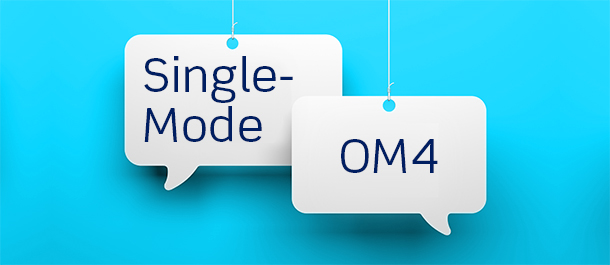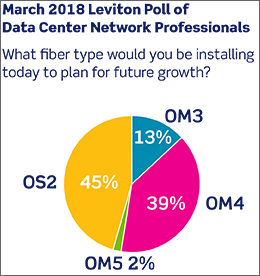The Market Has Spoken: OM4, Single-Mode Leave No Place for Unproven OM5

Typically, industry standards and associations set the stage for the next-generation of cabling and infrastructure that support network communications. But there are instances when the market decides to take a different route. This is currently the case with the recently standardized OM5 fiber. Even though TIA developed a standard for OM5 (TIA-492AAAE), this new fiber type very likely won’t see wide industry adoption because there is no current or planned application that requires it.
Due to new transceiver launches, coupled with customer perception of their needs and network requirements, the market is ignoring the new, unproven OM5 cable and sticking with proven solutions like OM4 and single-mode fiber.
For example, Cisco's recently launched 40/100G BiDi transceiver creates a clean line and transition path for OM4 in 40 and 100 Gb/s ports. This new dual-rate transceiver — QSFP-40/100-SRBD — uses a duplex LC interface. Cisco does not really want their customers to install new cabling: they want them to be able to use their existing OM3 or OM4 cabling and upgrade with new transceivers or new switches. And when data centers managers plan for speeds and distances beyond 40 or 100 Gb/s, they will move to single-mode fiber.

Source: Cisco 100GBASE-SQGP 100G Modules Data Sheet, May 2018
Transceiver manufacturers are taking a stand and promoting the benefits of reusing existing cabling backbone to speed network upgrades to avoid network disruptions and unnecessary additional costs. There is nowhere in this path for another multimode fiber like OM5.
The current 100 Gb/s transceivers with the highest sales volumes — and the expected high runners for 200 and 400 Gb/s —all work with OM4 or OS2. OM5 offers no real benefit.
The chart below shows the some of the top-selling 100 Gb/s transceivers:
Below are the expected high-volume 200 and 400 Gb/s transceivers:
When it comes to network infrastructure, users are reluctant to replace their entire cable backbone. And even with a greenfield installation, they are unlikely to install something different from their existing facilities unless the added capabilities (bandwidth and reach) are extraordinary. Customer and market perception is crystalizing on OM4 for multimode, and when a jump in fiber type is necessary and OM4 will no longer suffice, single-mode is by far the recognized next step.

This trend is supported by a recent Leviton poll that found a significant jump in OS2 single-mode, compared to surveys from previous years.
Some of the follow-up comments from the Leviton survey included responses about OM5:
“I do not believe that OM5 offers a real advantage, it’s mainly a marketing ploy by manufacturers.” — IT manager at a global financial company
“OM5 isn’t needed. There is no real place for it between OM4 and OS2.” — communications consultant
With the continued advancement in higher speed technologies, network engineers and IT infrastructure managers are faced with an overwhelming amount of choices for their network designs. For example, there are 13 different 100 Gb/s transceiver options available today! IT managers want a cabling manufacturer that can help them understand what all these options mean, and help them build a more flexible infrastructure that can handle future network upgrades.
You can learn more about fiber cabling trends in our recent white paper "Navigating Cabling Options for Enterprise and Cloud Data Centers."


